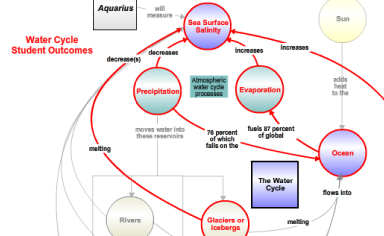|
|
| Hover over images for caption; click for a closer view and longer descriptions |
COSEE-Ocean Systems (COSEE-OS), with a team of researchers and other experts from the
University of Maine (UMaine),
New England Aquarium, and the
Institute for Broadening Participation, was established to implement
several integrated activities, each designed to improve COSEE's impact on rural and inland communities.
Since Fall 2005, COSEE-OS has investigated issues in educational research that pertain to pedagogy, practice,
and the learning process. User feedback has reinforced the desire for interactive products and processes that
highlight fundamental concepts as well as their "big picture" connections. In addition to developing the
Concept Linked Integrated Media Builder
(a suite of interactive software consisting of the
Ocean-Climate Interactive and the
Concept Map Builder) and the
Scientist-Educator and
Faculty/Graduate-Student Collaborative
workshop models, COSEE-OS has facilitated over 40
webinars, reaching more than 1,200
scientists, educators, and students in 44 states and 18 countries as of March 2013.
As part of ongoing efforts to train the next generation of scientists in the ocean sciences "pipeline",
COSEE-OS director Annette deCharon works with Dr. Mary Jane Perry and others to integrate pedagogical tools such
as concept mapping into UMaine's School of Marine Sciences coursework. Mary Jane has played a key role in this effort, co-teaching
a course as part of UMaine's
Semester by the Sea program
during which students used concept mapping as a communications tool. COSEE-OS also involves graduate students in education and outreach
through
school district partnerships.
By improving science literacy using the exciting context of the ocean, COSEE-OS hopes to reach the broadest possible audience by:
- Building and training educator-scientist teams who work together to distinguish meaningful, key messages for K–16 audiences
- Using concept mapping to help scientists and educators "be on the same page" when discussing ocean literacy topics
- Translating concept maps into innovative multimedia products
- Partnering with NASA instructional designers to showcase concepts within ocean systems contexts
- Offering a variety of free public webinars to help scientists reach broader audiences
- Supporting the use of real-time data by showcasing the research of eminent scientists and posting their data online for use by educators and students



